From August 2023 the comments on statistics, a short description of selected, recently issued statistical data in the area of monetary statistics and the non-residents sector statistics, are no longer published. They are replaced by Statistical releases.
Comments on the balance of payments, gross external debt and the international investment position in 3Q 2021
The current and capital account of the balance of payments ran a surplus of EUR 4.7bn in the third quarter of 2021, which is an increase of EUR 2.5bn from the same period of the previous year, primarily as a result of the sharp increase in revenues from tourism. If the last four quarters are observed, the surplus in the current and capital account in the period up to the end of September 2021 totalled 6.0% of GDP, which was 3.9 percentage points more than in the entire 2020.
In line with the substantial growth in the current and capital account surplus, the financial account of the balance of payments saw a notable net capital outflow. The gross external debt-to-GDP-ratio improved from 84.5% at end-June to 79.4% at end-September 2021 due to the mild decrease in debt liabilities of domestic sectors and nominal GDP growth. In the same period, the ratio of net international investment position to GDP improved even more, from –46.6% of GDP at the end of the second quarter to –35.5% of GDP at the end of the third quarter of 2021, mostly as a result of the seasonal improvement in the net foreign position of credit institutions.
The current and capital account of the balance of payments ran a surplus of EUR 4.7bn in the third quarter of 2021, which is an increase of EUR 2.5bn from the same period of the previous year (Figure 1a). The surge in the surplus, which almost amounted to the record high of the third quarter of 2019, was foremost due to the noticeable increase in revenues from travel services and, to a much lesser extent, the rise in net remittance income and better use of EU funds. In contrast, the increase in the current and capital account surplus was mitigated by the continued deepening of the foreign trade deficit and, to a smaller extent, higher profitability of banks and enterprises in foreign ownership, which was associated with the rapid domestic economic recovery from the pandemic crisis and the rebound of domestic demand. If the last four quarters are observed, the surplus in the current and capital account in the period up to the end of September 2021 totalled 6.0% of GDP, which was 3.9 percentage points more than in the entire 2020 (Table 1).
Imports of goods grew faster than exports (29.4% vs 24.4%) in the third quarter of 2021, which, paired with a noticeably larger imports base, led to a substantial increase in the foreign trade deficit (of EUR 0.8bn) relative to the same period of 2020. The annual growth rates were lower than in the quarter before (when exports and imports grew annually by 45.8% and 41.5%, respectively), but this was mostly due to the gradual waning of the base effect associated with the last year’s outbreak of the coronavirus pandemic. Developments in the third quarter of 2021 largely reflect the surge in domestic and foreign demand for goods and the rise in global prices of raw materials. The impact of these factors is particularly visible in comparison with goods trade in the pre-crisis period. Total goods exports and imports were larger by 13.7% and 16.8%, respectively, in the third quarter of 2021 than in the same period of 2019, with the deficit growing by 21.2% in the same period.
The rise in the surplus in foreign trade in services in the third quarter of 2021 (by EUR 3.3bn from the same period of the previous year) was due to a doubling of income from tourist spending of foreign guests during the peak tourist season relative to 2020, which was also 2.2% larger than the record high from the third quarter of 2019. Much better tourism performance over the summer months compared with Mediterranean competitors was mostly attributable to the favourable epidemiological situation and the fact that most guests use road transport as a means of arrival in Croatia due to the proximity of the main tourist-generating markets.
The deterioration in the balance in the primary income account in the third quarter of 2021 relative to the same period of 2020 (of EUR 0.2bn) was a result of larger expenditures on direct equity investments due to the increase in profitability of foreign-owned banks and enterprises (primarily in accommodation activities). These developments were mitigated by the growth in revenues from compensation of persons temporarily employed abroad and lower interest expenditures on the external debt of domestic sectors (particularly the government sector). At the same time, the overall surplus in the secondary income and capital transaction accounts edged up (by EUR 0.1bn) owing to the continued enhanced absorption of EU funds and larger revenues from personal transfers.
| a) Current and capital account | b) Financial account |
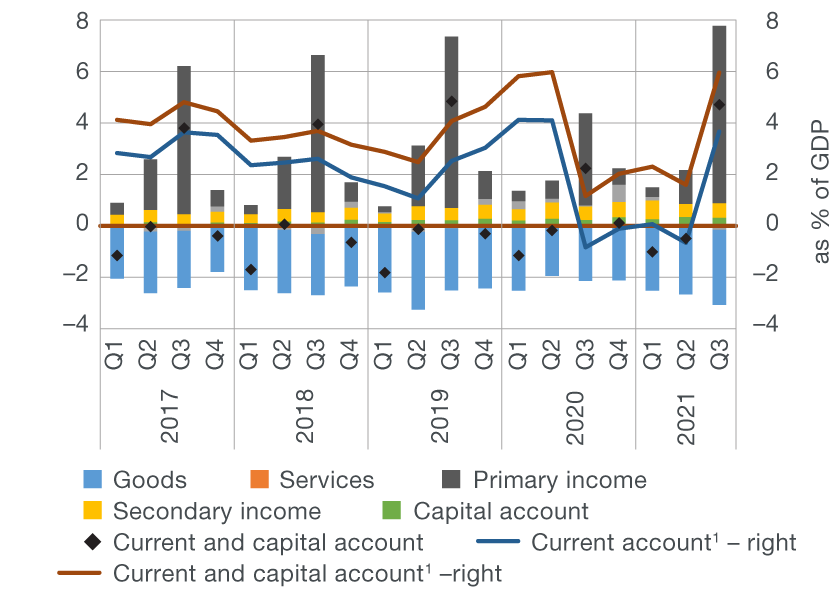 |
 |
1 Sum of the last four quarters.
2 Excluding the change in the gross international reserves and foreign liabilities of the CNB.
Note: In the figure showing the financial account, the positive value denotes net capital outflow abroad and the negative value denotes net capital inflow.
Source: CNB.
In line with the sharp increase in the current and capital account surplus, the financial account of the balance of payments saw a net capital outflow of EUR 4.2bn in the third quarter of 2021 (Figure 1b), an increase of EUR 2.2bn from the same period of the previous year. Broken down by individual accounts, this year’s net capital outflow was largely the outcome of the growth in gross international reserves and, to a slightly lesser extent, net outflows recorded in the other investment and portfolio investment accounts. Foreign direct investments recorded a net inflow in the same period.
The net inflow of foreign direct investments (of EUR 0.6bn) seen in the third quarter of 2021 was mostly associated with retained profit of banks and enterprises in foreign ownership, which was noticeably larger than in the same period of 2020. Direct equity investments in Croatia also increased, but solely due to debt-to-equity swaps. Excluding these transactions, direct equity investments remained at approximately the same, relatively high, level as in the third quarter of 2020, with most transactions relating to the real estate sector and the smaller contribution coming from investments in the automobile industry. The net inflow of foreign direct investments was mitigated by the growth in debt claims associated with lending to affiliated enterprises abroad.
The net capital outflow in the portfolio investment account (of EUR 0.6bn) was the outcome of the parallel increase in foreign assets and the decrease in foreign liabilities in the third quarter of 2021. Other domestic sectors recorded the sharpest increase in assets thanks to investments of domestic institutional investors in foreign debt securities, while the government reduced its liabilities mostly owing to the July repayment of bonds issued in the domestic market, some of which were held by non-residents.
Table 1 Balance of payments

1 Excluding the change in the gross international reserves and foreign liabilities of the CNB. The investment of a portion of international reserves in reverse repo agreements results in a simultaneous change in CNB assets (recorded in the reserve assets account) and liabilities (recorded in the other investment account) and thus has a neutral impact both on changes in the central bank’s net foreign position and the overall financial account balance.
2 Sum of the last four quarters.
Note: The positive value of financial transactions denotes net capital outflow abroad and the negative value denotes net capital inflow.
Source: CNB.
The substantial net capital outflow (of EUR 1.4bn) in the other investment account in the third quarter of 2021 was the result of a surge in net foreign assets of banks driven by the inflow of foreign exchange in the peak tourist season. The net outflow of capital was diminished by the fall in government debt claims as the amount of funds received from the EU budget exceeded the amount of funds distributed to end users. In addition, an increase was seen in central bank liabilities based on allocated special drawing rights of the International Monetary Fund (IMF) and the larger volume of repo transactions[1].
However, special drawing rights and repo transactions also increased gross international reserves by the same amount. In addition, the growth in reserves was fuelled even more by the inflow of government foreign currency deposits with the CNB due to the larger inflows of foreign exchange to the government from EU funds and the European Commission’s pre-financing payment under the National Recovery and Resilience Plan. As a result, gross international reserves grew strongly in the third quarter of 2021 (by EUR 2.8bn), reaching EUR 24.4bn at the end of September 2021, and growing by 13.1% from the end of June 2021.
The stock of gross external debt stood at EUR 44.1bn at the end of September 2021, which was EUR 0.2bn less than at the end of June (Figure 2a), owing to the reduction in debt of all domestic sectors with the exception of the central bank. Other domestic sectors reduced their debt the most, including liabilities to affiliated creditors (by EUR 0.7bn). Credit institutions and government also reduced their debt, by EUR 0.5bn and EUR 0.2bn, respectively. Central bank debt increased in the same period (by EUR 1.2bn) due to the said increase in special drawing rights and repo transactions. As a result of the decrease in total gross external debt and the sharp increase in GDP, the relative indicator of the gross external debt improved substantially in the third quarter, standing at 79.4% of GDP at end-September 2021, which was 5.0 percentage points less than at the end of June 2021 (Figure 2b).
Figure 2 Gross external debt
| a) Change in gross external debt | b) Stock of gross external debt |
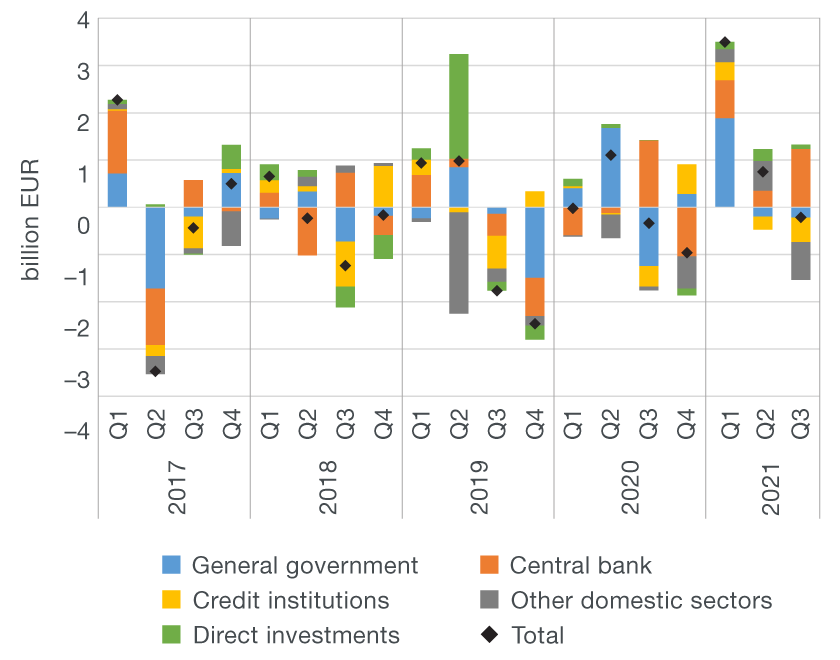 |
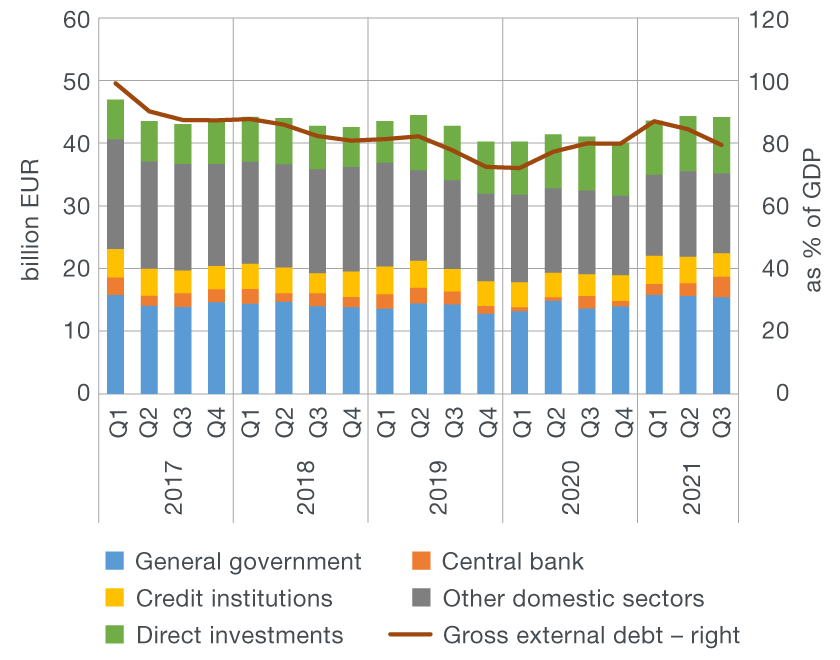 |
Note: Changes in gross external debt are a result of net transactions of domestic sectors and exchange rate and other adjustments.
Source: CNB.
The decline in gross external debt in absolute terms coincided with an even larger increase in debt claims of domestic sectors (primarily the assets of the central bank and credit institutions), which finally led to a sharp reduction in net external debt (of EUR 5.0bn) in the third quarter of 2021. Thus, net external debt stood at EUR 2.7bn at the end of September, or 4.8% of GDP, down by 9.8 percentage points from the end of June 2021.
As a result of the sharp decrease in net external debt, the net international investment position improved from EUR –24.5bn at the end of June to EUR –19.7bn at the end of September 2021 thanks to all domestic sectors, in particular the seasonal improvement in the foreign position of credit institutions (Figure 3a). The relative indicator of the net international investment position improved noticeably, from –46.6% of GDP at the end of June to –35.5% of GDP at the end of September 2021 (Figure 3b).
Figure 3 International investment position (net)
| a) Position by sector | b) Relative indicator by type of investment |
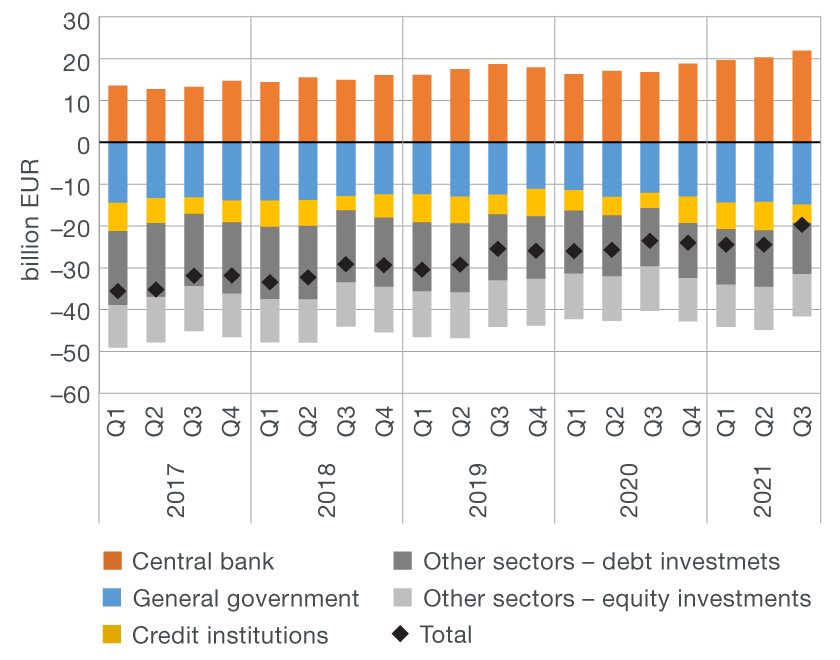 |
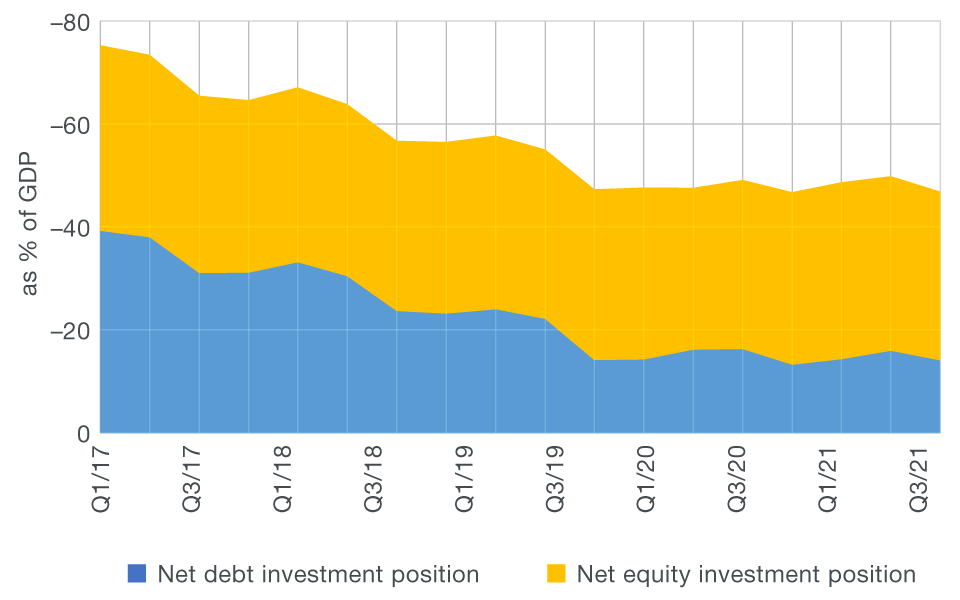 |
Note: The international investment position (net) equals the difference between domestic sectors' foreign assets and liabilities at the end of a period. The negative value of the net international investment position indicates that foreign liabilities of Croatian residents are greater than their foreign assets. Included are assets and liabilities based on debt instruments, equity investments, financial derivatives, and other instruments. Figure 3b includes financial derivatives and other liabilities in the net debt investment position.
Source: CNB.
Data revision
Data on the balance of payments, gross external debt and the international investment position are revised in accordance with the commonly used practice, based on subsequently available data.
Detailed balance of payments data
Detailed gross external debt data
Detailed data on the international investment position
-
The investment of a portion of international reserves in reverse repo agreements and the inflow based on IMF’s special drawing rights results in a simultaneous change in CNB assets (recorded in the gross reserve assets account) and liabilities (recorded in the other investment account) and thus has a neutral impact both on changes in the central bank's net foreign position and the overall financial account balance. ↑
